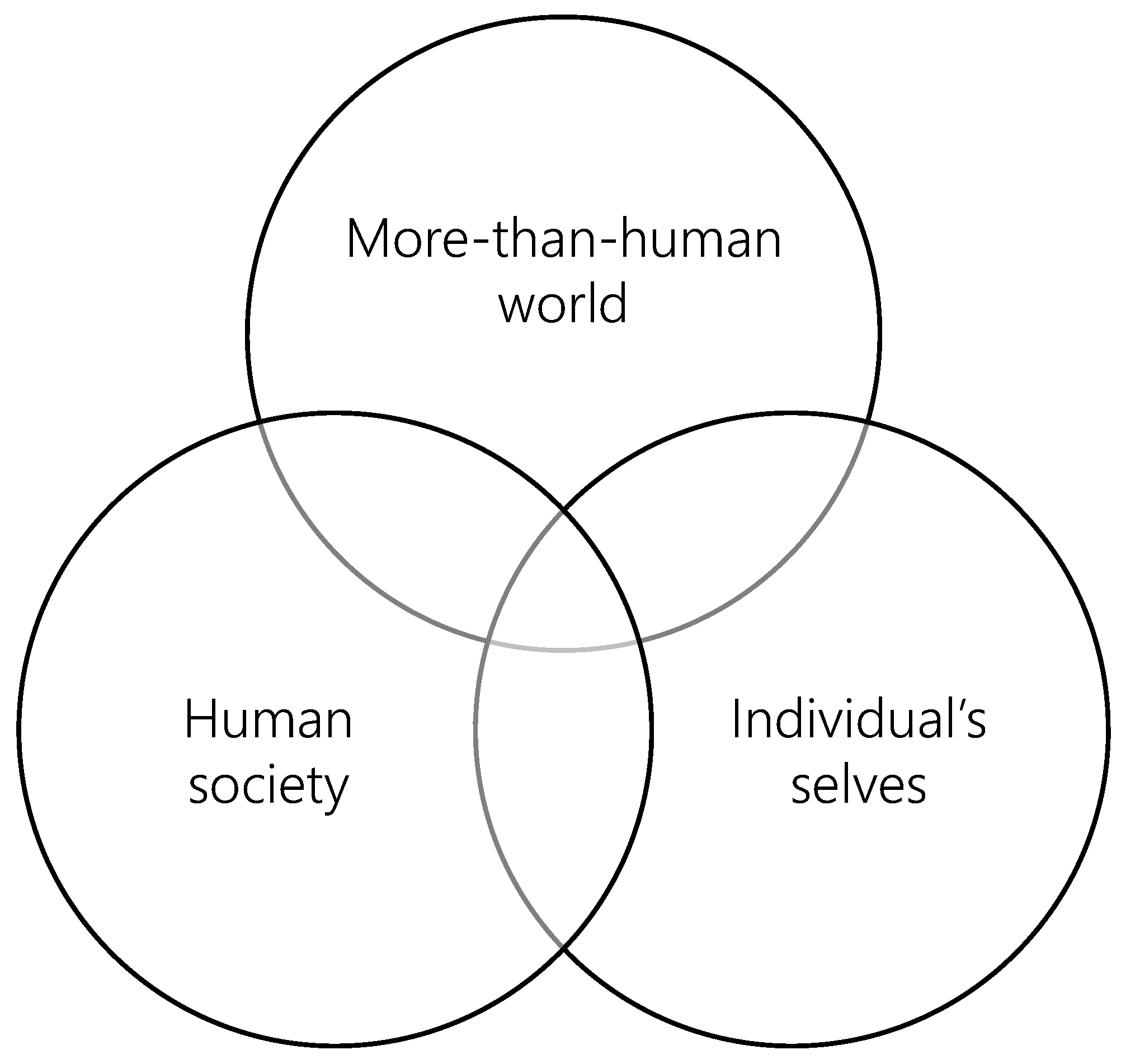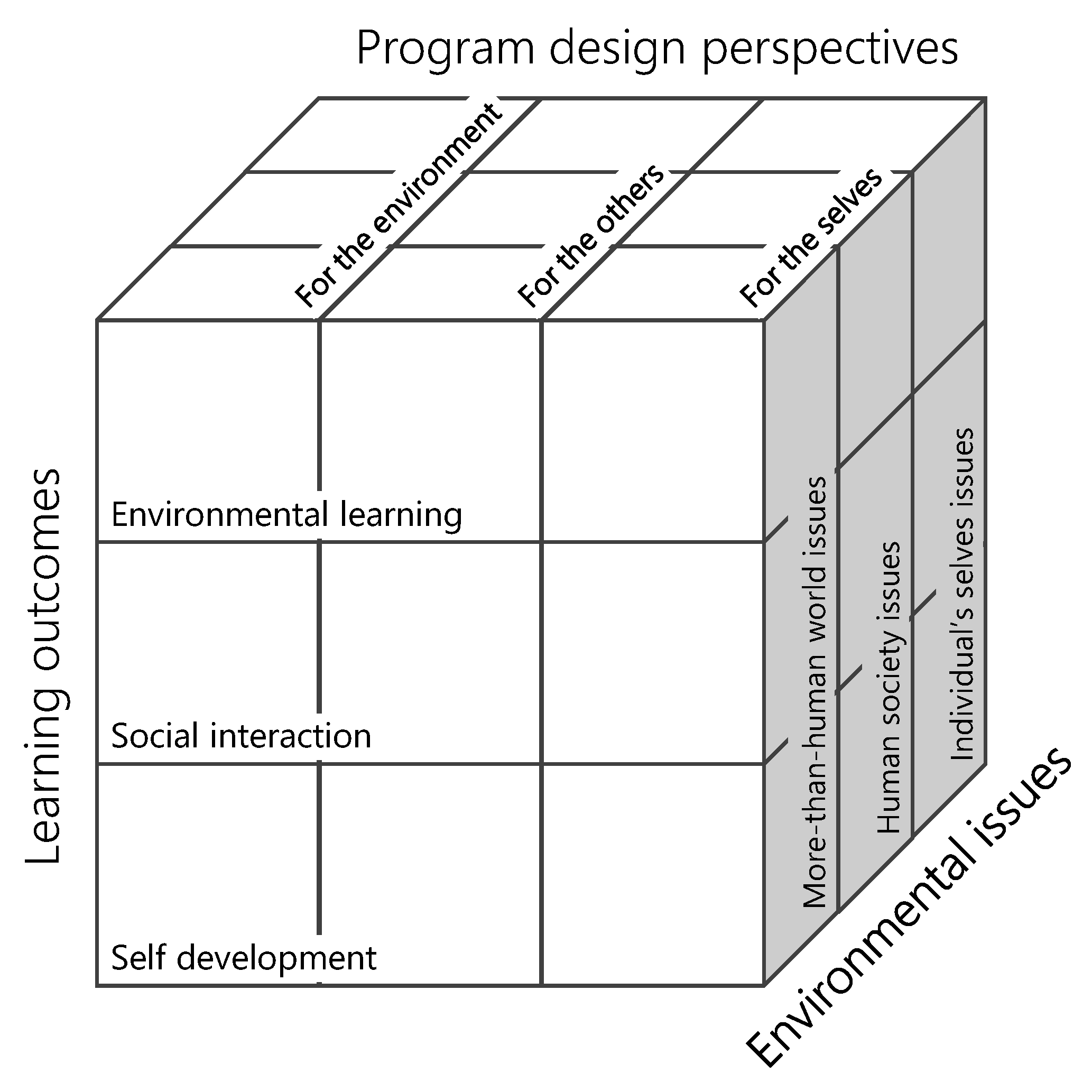What Could and Should Ecological Civilization Education Be?
Abstract
:1. The Identical Goals of ECE and EE
2. The Triple-Property Model of ECE Program Design Perspectives
3. The Triple-Property Model of ECE Outcomes
4. The Cube of ECE/EE
Supplementary Materials
Author Contributions
Funding
Conflicts of Interest
References
- Haeckel, E. Generelle Morphologie der Organismen; Georg Reimer: Berlin, Germany, 1866; Volume 2. [Google Scholar]
- Stauffer, R.C. Haeckel, Darwin, and ecology. Q. Rev. Biol. 1957, 32, 138–144. [Google Scholar] [CrossRef]
- ESA. What Is Ecology? Available online: https://www.esa.org/about/what-does-ecology-have-to-do-with-me/ (accessed on 16 October 2020).
- Corlett, R.T. The Anthropocene concept in ecology and conservation. Trends Ecol. Evol. 2015, 30, 36–41. [Google Scholar]
- Crutzen, P.J.; Stoermer, E.F. The “Anthropocene”. Glob. Chang. Newsl. 2000, 41, 17–18. [Google Scholar]
- Stapp, W.B. The concept of environmental education. Environ. Educ. 1969, 1, 30–31. [Google Scholar] [CrossRef]
- Sauvé, L. Currents in Environmental Education: Mapping a Complex and Evolving Pedagogical Field. Can. J. Environ. Educ. 2005, 10, 11–37. [Google Scholar]
- Abram, D. The Spell of the Sensuous: Perception and Language in a More-Than-Human World; Vintage Books: New York, NY, USA, 1996. [Google Scholar]
- Taylor, A. Beyond stewardship: Common world pedagogies for the Anthropocene. Environ. Educ. Res. 2017, 23, 1448–1461. [Google Scholar] [CrossRef]
- Sauvé, L. Environmental education between modernity and postmodernity: Searching for an integrating educational framework. Can. J. Environ. Educ. 1999, 4, 9–35. [Google Scholar]
- UN. Transforming Our World: The 2030 Agenda for Sustainable Development; General Assembly: New York, NY, USA, 2015. [Google Scholar]
- Steg, L.; de Groot, J.I. Environmental values. In The Oxford Handbook of Environmental and Conservation Psychology; Clayton, S.D., Ed.; Oxford University Press: New York, NY, USA, 2012; pp. 81–92. [Google Scholar]
- Myers, D.G. Social Psychology, 11th ed.; Myers, D.G., Ed.; McGraw-Hill: New York, NY, USA, 2012. [Google Scholar]
- Corrigan, P.W.; Morris, S.B.; Michaels, P.J.; Rafacz, J.D.; Rüsch, N. Challenging the public stigma of mental illness: A meta-analysis of outcome studies. Psychiatr. Serv. 2012, 63, 963–973. [Google Scholar] [CrossRef] [PubMed]
- Smith, R.A.; Applegate, A. Mental health stigma and communication and their intersections with education. Commun. Educ. 2018, 67, 382–393. [Google Scholar] [CrossRef] [PubMed] [Green Version]
- Balding, M.; Williams, K.J. Plant blindness and the implications for plant conservation. Conserv. Biol. 2016, 30, 1192–1199. [Google Scholar] [CrossRef] [PubMed]
- Mezirow, J. Learning to think like an adult. In Learning as Transformation: Critical Perspectives on a Theory in Progress; Mezirow, J., Ed.; Jossey-Bass: San Francisco, CA, USA, 2000; pp. 3–33. [Google Scholar]
- Brown, K.M. Leadership for social justice and equity: Evaluating a transformative framework and andragogy. Educ. Adm. Q. 2006, 42, 700–745. [Google Scholar] [CrossRef]
- Schusler, T.M.; Krasny, M.E. Environmental action as context for youth development. J. Environ. Educ. 2010, 41, 208–223. [Google Scholar] [CrossRef]
- Finger, M.; Asún, J.M. Adult Education at the Crossroads: Learning Our Way Out; Zed Books: London, UK, 2001. [Google Scholar]
- Geall, S. Clear Waters and Green Mountains: Will Xi Jinping Take the Lead on Climate Change? Lowy Institute for International Policy: Sydney, AU, USA, 2017. [Google Scholar]
- Wu, M.; Zhu, Z.; Chen, J.; Niu, L.; Liu, C.-C. Autobiographical memory functions: An emancipatory approach to construct environmental education outcomes. Environ. Educ. Res. 2020, 26, 632–649. [Google Scholar]
- Powell, R.B.; Stern, M.J.; Frensley, B.T.; Moore, D. Identifying and developing crosscutting environmental education outcomes for adolescents in the twenty-first century (EE21). Environ. Educ. Res. 2019, 25, 1281–1299. [Google Scholar] [CrossRef]
- Ardoin, N.M.; Bowers, A.W.; Roth, N.W.; Holthuis, N. Environmental education and K-12 student outcomes: A review and analysis of research. J. Environ. Educ. 2018, 49, 1–17. [Google Scholar] [CrossRef]
- Krasny, M.E. Advancing Environmental Education Practice; Cornell University Press: Ithaca, NY, USA, 2020. [Google Scholar]
- Wu, M. The Construction and Applicaton of an Outcome Evaluation Framework for Environmental Education Programs; University of Chinese Academy of Sciences: Beijing, China, 2016. [Google Scholar]
- Wu, M. The Evaluation Report of Roots & Shoots Clear Water project in 2017; Roots & Shoots Beijing Office: Bejing, China, 2018. [Google Scholar]
- Kollmuss, A.; Agyeman, J. Mind the gap: Why do people act environmentally and what are the barriers to pro-environmental behavior? Environ. Educ. Res. 2002, 8, 239–260. [Google Scholar] [CrossRef] [Green Version]
- Siegel, L.; Cutter-Mackenzie-Knowles, A.; Bellert, A. Still ‘Minding the Gap’Sixteen Years Later:(Re) Storying Pro-Environmental Behaviour. Aust. J. Environ. Educ. 2018, 34, 189–203. [Google Scholar] [CrossRef]


| Programs for Whom? | Eco-Centric Concerns: for the Environment | Altruistic Concerns: for Others | Egoistic Concerns: for One’s Selves | ||||||
|---|---|---|---|---|---|---|---|---|---|
| Corresponding currents | Naturalist: connecting with the environment Value-centered: respecting the environment Socially critical: transforming attitudes and behaviors toward respecting the environment Feminist: caring for the environment [7] | Humanistic/Mesological: knowing and appreciating one’s milieu of life Bioregionalist: local or regional community ecodevelopment Socially critical: transforming attitudes and behaviors toward justice and equality Ethnographic: valuing one’s cultural relationship with the environment Sustainable development/Sustainability: promoting economic development that considers social equity and ecological sustainability [7] | Socially critical: transforming attitudes and behaviors, and empowerment Eco-Education: individual development through interaction with the environment [7] | ||||||
| All-purpose currents | Conservationist/Resourcist: conservation; Problem-solving: addressing problems; Systemic: systemic thinking; scientific: natural and social science inquiry; Holistic: “organically” understanding the world; Praxic: actions [7] | ||||||||
| Program standpoints | Based on respecting the intrinsic value or subjectivity of the environment and the human–environment inter-subjectivity to protect the environment | Based on the value of the environment for social interactions (the instrumental value of the environment) to protect the environment | Based on the value of the environment for an individual’s self-development (the instrumental value of the environment) to protect the environment | ||||||
| Preliminary definitions | Non-instrumentally connecting to the environment: equal-status contact [13] with the environment, through seeing or listening to the lived experiences of it rather than simply spending time with it [14,15] | Empathically understanding the environment: supporting individuals to put themselves in the environment’s position through creative activities such as story writing, drawing, imagining, role playing, and appropriate anthropomorphization [16] | Respecting the environment, viewing and treating it with justice: encouraging transformative learning, through disrupting taken-for-granted assumptions, stirring critical reflection, and building rational discourse [17,18] | Caring for the environment: facilitating learning through environmental-action [19] or participatory action research [20] programs that are aimed at helping the environment become what it could be, based on the respect for its subjectivity | Realizing the utility of the environment for social development | Becoming conscious of the intersectionality of the environment in promoting equality in other issues | Perceiving the influence of the environment to enhance interpersonal relationships, such as social skills | Valuing the functions of the environment to empower individuals: helping to build self-efficacy and gaining a positive evaluation of one’s abilities, thereby promoting physical and mental health | Appreciating the affordance of the environment for other aspects of self-growth: helping to boost self-esteem, improve personal traits, expand hobbies, and set up ideals, thereby promoting physical and mental health |
| Environmental learning | Environmental awareness | The environment |
| Environmental problems | ||
| Environmental protection | ||
| Environmental exploration | ||
| Environmental knowledge | The environment | |
| Environmental problems | ||
| Environmental protection | ||
| Environmental exploration | ||
| Environmental skills | Environmental protection | |
| Environmental exploration | ||
| Environmental attitudes | The environment | |
| Environmental problems | ||
| Environmental protection | ||
| Environmental exploration | ||
| Environmental behaviors | Environmental protection | |
| Environmental exploration | ||
| Social interaction | Social skills | Interpersonal networks |
| Communication skills | ||
| Teamwork skills | ||
| Reminiscing with other participants | ||
| Sharing with nonparticipants | ||
| Self-development | Self-efficacy | |
| Self-esteem | ||
| Traits | ||
| Hobbies | ||
| Visions | ||
Publisher’s Note: MDPI stays neutral with regard to jurisdictional claims in published maps and institutional affiliations. |
© 2021 by the authors. Licensee MDPI, Basel, Switzerland. This article is an open access article distributed under the terms and conditions of the Creative Commons Attribution (CC BY) license (https://creativecommons.org/licenses/by/4.0/).
Share and Cite
Wu, M.; Liu, C.-C. What Could and Should Ecological Civilization Education Be? Sustainability 2021, 13, 11735. https://doi.org/10.3390/su132111735
Wu M, Liu C-C. What Could and Should Ecological Civilization Education Be? Sustainability. 2021; 13(21):11735. https://doi.org/10.3390/su132111735
Chicago/Turabian StyleWu, Meng, and Chi-Chang Liu. 2021. "What Could and Should Ecological Civilization Education Be?" Sustainability 13, no. 21: 11735. https://doi.org/10.3390/su132111735
APA StyleWu, M., & Liu, C.-C. (2021). What Could and Should Ecological Civilization Education Be? Sustainability, 13(21), 11735. https://doi.org/10.3390/su132111735





